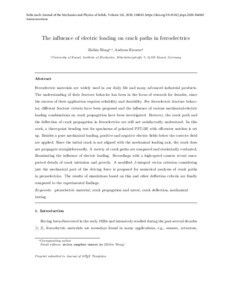The influence of electric loading on crack paths in ferroelectrics
| dc.date.accessioned | 2021-05-07T13:31:45Z | |
| dc.date.issued | 2020-05-30 | |
| dc.identifier | doi:10.17170/kobra-202104303786 | |
| dc.identifier.uri | http://hdl.handle.net/123456789/12810 | |
| dc.description | Autorenversion | ger |
| dc.language.iso | eng | eng |
| dc.rights | Attribution-NonCommercial-NoDerivatives 4.0 International | * |
| dc.rights.uri | http://creativecommons.org/licenses/by-nc-nd/4.0/ | * |
| dc.subject | piezoelectric material | eng |
| dc.subject | crack propagation and arrest | eng |
| dc.subject | crack deflection | eng |
| dc.subject | mechanical testing | eng |
| dc.subject.ddc | 620 | |
| dc.title | The influence of electric loading on crack paths in ferroelectrics | eng |
| dc.type | Aufsatz | |
| dcterms.abstract | Ferroelectric materials are widely used in our daily life and many advanced industrial products. The understanding of their fracture behavior has been in the focus of research for decades, since the success of their application requires reliability and durability. For ferroelectric fracture behavior, different fracture criteria have been proposed and the influence of various mechanical-electric loading combinations on crack propagation have been investigated. However, the crack path and the deflection of crack propagation in ferroelectrics are still not satisfactorily understood. In this work, a three-point bending test for specimens of polarized PZT-5H with off-center notches is set up. Besides a pure mechanical loading, positive and negative electric fields below the coercive field are applied. Since the initial crack is not aligned with the mechanical loading axis, the crack does not propagate straightforwardly. A variety of crack paths are compared and statistically evaluated, illuminating the influence of electric loading. Recordings with a high-speed camera reveal unexpected details of crack initiation and growth. A modified J-integral vector criterion considering just the mechanical part of the driving force is proposed for numerical analyses of crack paths in piezoelectrics. The results of simulations based on this and other deflection criteria are finally compared to the experimental findings. | eng |
| dcterms.accessRights | open access | |
| dcterms.creator | Wang, Zhibin | |
| dcterms.creator | Ricoeur, Andreas | |
| dc.relation.doi | doi:10.1016/j.jmps.2020.104043 | |
| dc.subject.swd | Piezoelektrischer Stoff | ger |
| dc.subject.swd | Rissausbreitung | ger |
| dc.subject.swd | Mechanische Prüfung | ger |
| dc.subject.swd | Ferroelektrizität | ger |
| dc.type.version | publishedVersion | |
| dcterms.source.identifier | eissn:0022-5096 | |
| dcterms.source.journal | Journal of the Mechanics and Physics of Solids | eng |
| dcterms.source.volume | Volume 142 | |
| ubks.embargo.terms | 2022-05-30 | |
| ubks.embargo.end | 2022-05-30 | |
| kup.iskup | false | |
| dcterms.source.articlenumber | 104043 |
Dateien zu dieser Ressource
Das Dokument erscheint in:
-
Publikationen [13]


